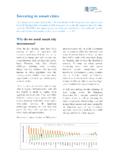Transcription of Green Infrastructure to Combat Climate Change
1 Green Infrastructure to Combat Climate Change A Framework for Action in Cheshire, Cumbria, Greater Manchester, Lancashire, and Merseyside March 2011. Prepared by Community Forests Northwest for the Northwest Climate Change Partnership European Union European Regional Development Fund Contents Executive Summary 5. The Vision 7. The Case for Combating Climate Change 9. The Case for Green Infrastructure 11. Developing the Framework for Action 12. The North West Climate Change Action Plan 12. The GRaBS Project 13. Delivering the Framework for Action 14. How to Deliver?
2 14. Who to Deliver? 14. District and Neighbourhood Level Delivery 14. Pan-Authority (or Sub/City Region) Level Delivery 15. The Actions 16. 1. Overarching Actions 18. 2. Managing Surface Water 23. 3. Managing High Temperatures 26. 4. Carbon Storage and Sequestration 29. 5. Managing Riverine Flooding 32. 6. Food Production 35. 7. Material Substitution 38. 8. Providing Low Carbon Fuels 40. 9. Reducing the Need to Travel by Car 43. 10. Helping Other Species Adapt 45. 11. Managing Visitor Pressure 48. 12. Reducing Soil Erosion 51. 13. Managing Water Resources 54.
3 14. Managing Coastal Flooding 56. Legislative and Policy Context 60. EU Legislation and Policy 60. UK Legislation, Policy and Guidance 60. Abbreviations 62. Organisations Shaping the Framework 63. 4 Photo: McCoy Wynne Executive Summary The latest scientific evidence has reinforced the regeneration, low carbon economy, transport, health, fact that Climate Change is the greatest threat recreation, tourism, agriculture, and biodiversity. to our social well being and economic future. It is imperative that we all take what action we The Framework should be delivered by a broad range can now in order to both reduce greenhouse gas of organisations and professions.
4 Organisations emissions and ensure that our communities are include public agencies and service providers, adapting to anticipated Climate Change . local authorities, environmental, community and voluntary-sector organisations and non- Green Infrastructure provides a range of services governmental organisations, and those with remits that make both a substantial contribution for the agendas set out above. Professions include towards Climate Change adaptation and a limited planners and investment decision makers, transport yet important contribution towards Climate planners, developers, urban designers, landscape Change mitigation.
5 Such natural interventions architects, engineers, foresters, conservationists, are increasingly being recognised as a desirable farmers, and tourism managers. Many of the actions win-win' approach to combating Climate Change , will be delivered cumulatively by land owners and as they also help to deliver multiple other social, managers. This includes both larger, public sector, economic and environmental benefits. and easier to reach owners such as local authorities, as well as smaller, private sector, businesses, This Framework for Action has been developed individuals and harder to reach land owners.
6 Under the auspices of the North West Climate organisations that engage with and provide grants to Change Action Plan, with Community Forests the latter group will be increasingly important. Northwest commissioned by the Northwest Regional Development Agency on behalf of Delivery will largely be at three levels: pan-authority the Northwest Climate Change Partnership. The (or sub/city region), district, and neighbourhood. work was supported through the EU Interreg The pan-authority level is critical, but the best IVC GRaBS ( Green and Blue Space Adaptation results will be achieved when delivery takes place for Urban Areas and Eco Towns) project.
7 114 across all three levels. In addition, existing Green people from 75 organisations helped to shape the Infrastructure networks in the North West of England, Framework by taking part in the consultation. such as the Green Infrastructure Unit and Green Infrastructure Forum, should provide an ongoing This Framework is a guidance document to be used support and coordination role, helping to promote by stakeholders across Cheshire, Cumbria, Greater the implementation of this and associated Green Manchester, Lancashire, and Merseyside to influence Infrastructure frameworks, including the exchange of and provide evidence for policy and delivery on this best practice.
8 Crucial and long term agenda. Its success depends upon all stakeholders taking ownership of and The Framework sets out a number of actions to working in partnership to champion, tailor for their achieve the vision described overleaf. needs, embed into policy, and deliver the actions that are relevant to them. Indeed, Climate Change and Green Infrastructure are both cross-cutting, so this Framework adds value to the delivery of a broad range of agendas, including development and 5. 6 Photo: McCoy Wynne The Vision Green Infrastructure across Cheshire, Cumbria, Greater Manchester, Lancashire, and Merseyside is planned, designed, and managed by all relevant stakeholders, involving and engaging local communities, in order to Combat Climate Change and deliver other economic, social and environmental benefits.
9 All opportunities are taken to safeguard, create, enhance, maintain and promote Green Infrastructure in ways that optimise the Climate Change adaptation and mitigation services it provides. These include: Managing surface water Green Infrastructure Reducing the need to travel by car providing can help to manage surface water and sewer local recreation areas and Green travel routes to flooding by reducing the rate and volume of water encourage walking and cycling. runoff; it intercepts water, allows it to infiltrate into Helping other species adapt providing a more the ground, and provides permanent or temporary vegetated and permeable landscape through storage areas.
10 Which species can move northwards to new Managing high temperatures particularly Climate spaces'. in urban areas, where evaporative cooling Managing visitor pressure providing a and shading provided by Green Infrastructure recreation and visitor resource for a more outdoors can ensure that towns and cities continue to be lifestyle, and helping to divert pressure from attractive and comfortable places to live, work, visit landscapes which are sensitive to Climate Change . and invest. Reducing soil erosion using vegetation to Carbon storage and sequestration storing stabilise soils that many be vulnerable to carbon in soils and vegetation.






